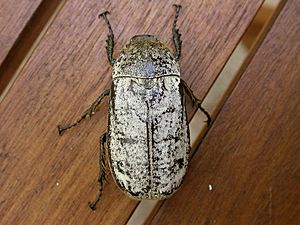Cane beetle facts for kids
Quick facts for kids Cane beetle |
|
|---|---|
 |
|
| Scientific classification | |
| Kingdom: | |
| Phylum: | |
| Class: | |
| Order: | |
| Family: | |
| Genus: |
Dermolepida
|
| Species: |
D. albohirtum
|
| Binomial name | |
| Dermolepida albohirtum (Waterhouse, 1875)
|
|
The cane beetle (scientific name: Dermolepida albohirtum) is a type of beetle that lives in Australia. It is a pest, meaning it causes harm to sugarcane plants. Adult cane beetles eat the leaves of sugarcane. However, their young, called larvae or grubs, cause even more damage. These grubs live underground and eat the plant's roots. This can kill the sugarcane plant or stop it from growing properly.
Cane beetles are also found in the Philippines. There, people call them salagubang.
Contents
Understanding the Cane Beetle's Life Cycle
Cane beetles have an interesting life cycle that causes problems for sugarcane. Adult cane beetles are white with black spots. They sometimes have a strong smell, like rotten meat.
How Cane Beetles Lay Eggs
Female cane beetles lay their eggs deep in the soil, usually about 20 to 45 centimeters (8 to 18 inches) down. They often choose the soil near the base of the tallest sugarcane plants. A female beetle can lay up to three groups of eggs. Each group has about 20 to 30 eggs.
The Grub Stage and Plant Damage
The eggs hatch into small, white larvae. These larvae are also known as greyback cane grubs. These grubs feed on the roots of sugarcane plants during all three stages of their growth. The most damage happens from February to May. During this time, the grubs eat a lot of the sugarcane roots. This feeding can severely harm the plants.
After 3 to 4 months, when the grub has eaten enough, it burrows deeper into the soil. There, it changes into a pupa. The pupa then develops into an adult beetle within about a month. However, the new adult beetle does not come out of the soil right away. It waits underground until the weather is just right.
Controlling Cane Beetles: Past Efforts
People have tried different ways to control cane beetles. One method involves using a special fungus called Metarhizium anisopliae. This fungus can help to kill the beetles. Other ways to control them are called biocontrol strategies.
However, many pest control methods can also harm other insects. Some of these insects are good for the environment. Because of this, it is hard to use some of these methods widely.
The Story of the Cane Toad Introduction
The cane beetle was one of the main reasons the cane toad (Rhinella marina) was brought to Australia. Another beetle, the Frenchi cane beetle (Lepidiota frenchi), was also a problem. People hoped the cane toad would eat these beetles and protect the sugarcane crops. This was an attempt at biological control.
While cane toads did eat some cane beetles, they preferred other insects. The cane toad itself became a big problem. Their population grew very quickly. Native animals, like quolls (a type of marsupial), were not used to the toad's poison. They would eat the toads and get sick or die. This caused a huge drop in the numbers of native predators, like the northern quoll.

